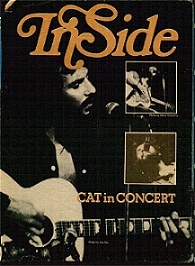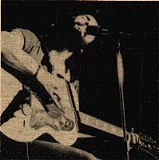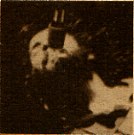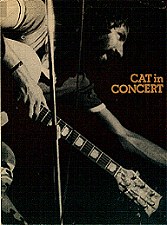Senior Scholastic, for those who have never heard
of this particular magazine. Senior Scholastic was an educational magazine which was
handed out to students in American High Schools, through out the 1970's. I still
remember the excitement of reading a Cat Stevens article from a somewhat boring school
magazine. He was featured at least 3 times during the years 1972 - 1973.
Senior Scholastic
1973
- Written by Ed Sparn
CAT
IN CONCERT

Some people think about doing it, and others do it. Its having the
courage to keep at it, or to fail.
Cat Stevens has been doing
it , that is, making music and pleasing large numbers of people, since he was roughly 17
years old. He has now reached the ripe old age of 25, and each of his new albums has
reached the status of instant gold on both sides of the Atlantic.
I had asked Cat Stevens in
one of his rare interviews what advice he might have for a young person who believed he or
she had musical talent. Did he have any advice that he wishes someone had given him at an
early age? Stick to it. keep the faith, and keep at it. That was the essence of his
advice.
Cat Stevens (his friends
call him Steve) is a living example of his own counsel. There are probably very few rock
fans who aren’t aware of the basic facts about Steve that illustrate this view of
life. He was born Steven Demitri Georgiu in London in 1948, to a Greek-born father and a
Swedish-born mother. He grew up in an apartment over his parents’ restaurant, in a
noisy part of London. At school his favorite subjects were music and art. He worked on
both of them even while getting into minor scrapes in and out of school.
At the age of 17 Steve was
discovered" by a fast-talking promotor. And right away he was pressed
into the cookie-cutter shape of instant stardom, with all the press agentry, business
exploitation, and heavy so-cializing that his new role called for. It was the
instant stardom formula from a Hollywood movie of the 1930’s. It was bound to take a
toll on the- performer himself. And it did. in 1969 Cat Stevens found himself hospitalized
with one lung collapsed, another threatening to go, and a case of tuberculosis. pressed
into the cookie-cutter shape of instant stardom, with all the press agentry, business
exploitation, and heavy so-cializing that his new role called for. It was the
instant stardom formula from a Hollywood movie of the 1930’s. It was bound to take a
toll on the- performer himself. And it did. in 1969 Cat Stevens found himself hospitalized
with one lung collapsed, another threatening to go, and a case of tuberculosis.
Cat Stevens emerged
from a long period of convalescence a changed person. The rollicking and bouncy
calypso-type beat of his early records gave way to a new sensitivity and lyricism. Some
critics compared his new work, such as the album Mona Bone Jakon. with the clarity
and simplicity of medieval ballads. He followed this up with new albums such as Tea for
the Tillerman, Teaser and the Firecat, and a coast-to-coast tour of the U.S. that was
a smash success with audiences and critics.
Through it all, Cat
Stevens has stayed essentially withdrawn and detached. He is a highly sensitive per--son,
introspective, and quiet. His manner during a~concert reflects his personaLity. He seems
ill at ease with the small talk and banter that some performers use. Instead, he hunches
his shoulders over his guitar or piano and throws himself into his music with total
absorption.
In line with this kind of
presentation, Steve says that he likes to avoid huge stadium scenes for his concerts. He
feels he might lose touch with his audience. think there is a kind at limit. Six thousand
people in a hail is about maximum. With more than that, you cant see the performer. On his
first tour of the U S , he played in. clubs such as the Troubadour in Los Angeles.
Later he played in larger auditoriums such as New York City’s Carnegie Hail,
In many ways TV is ideal
for the projection Of a highly intimate per former such as Cat Stevens. In fact, he has
just finished a 90-minute U.S. TV "debut" on ABC’s In Concert. The
music was exclusively Cat Stevens material, and was performed live at the Hollywood Bowl.
The program followed soon after the success of Steve’s most recent album, Foreigner.
which was high on the U.S. charts for some time.
Steve remarked that
touring is a lot of work and involves a lot of hassling. but he likes to do tin order to
keep in touch with a live audience. He feels his music benefits from it, and his work
would be less meaningful if he didn’t tour.
He manages to write his
music wherever he is, in ‘cars, planes, hotel rooms.. His song "To the
Eighteenth Avenue," from Catch Bull at Four, was written "in Kansas City
airport, running for gate 22.’
He works in London in his own
house, an older building in Fulham, which he renovated and decorated according to his own
designs. He has’a recording studio on one floor, a living area on another floor done
up in blacks, grays, and whites, and a loft bedroom with a skylight where he can lie in
bed and look up at the stars (London weather permitting).
It could be that many of
Steve’s ideas come to him in that setting, staring at the night sky, with interseller
fantasy flights that to him are more real than imagined. This is the environment Out of
which songs such as ‘Longer Boats," "Moonshadow," and "Freezing
Steel," are born, with their atmosphere of night flights into space. flying saucers,
and child-like lyricism. And somehow his music and lyrics, his presentation, make the
listener believe in it all.
Top of
Page
|